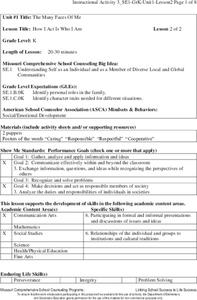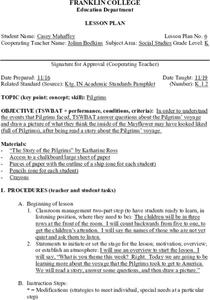Curated OER
Colors of Wildlife
Students observe wildlife animals. In this wildlife lesson, students cut out three different animals from a wildlife magazine. Then they compare the animals, verbally stating their similarities and differences.
Curated OER
Economy Introduction: Jack and the Bank Stock
Third graders explore the functions of money. For this economics lesson, 3rd graders read Jack and the Beanstalk to discover the three main functions of money.
Curated OER
William Tell Overture
Students explore the musical concepts of rhythm, melody, expression, and tone color in a three-activity unit about the William Tell Overture. They identify dynamics and tempo and play a vocal tone color singing game.
Pennsylvania Department of Education
Comparing Sets
Students count back with cubes to model subtraction problems. In this subtraction lesson plan, students compare sets of problems and record their results in a table.
Curated OER
The Plant and Animal Walk
Students draw pictures and write words to describe objects and experiences. They observe outside and draw at least three animals and three plants. Students observe plants and animals describing how they are alike and how they are...
Curated OER
History Fair
High schoolers create a History Fair. They examine the National History Day Competition and are encouraged to participate.
Missouri Department of Elementary
How We Are Alike And Different
Scholars develop social awareness by exploring the concept of similarities and differences. Learners examine two beverages and use a Venn diagram to identify similarities and differences. They tally each item to identify if they are more...
Missouri Department of Elementary
How I Act Is Who I Am
A lesson centers itself around the topic of family roles. A whole-class discussion uses puppets and posters to go in-depth into the following character traits; caring, responsibility, respect, and cooperation. The discussion closes with...
Missouri Department of Elementary
What Is Comfortable and Uncomfortable Touch?
Two stuffed animals open a lesson that examines two types of touch. Scholars discuss the difference between comfortable and uncomfortable touch. They offer examples then brainstorm ways an individual can keep safe from uncomfortable...
Missouri Department of Elementary
What Are Safe and Unsafe Drugs/Medicines/Objects?
Encourage responsible decision-making while boosting sorting skills with a lesson that looks at safe and unsafe situations. Scholars use two bags, one happy the other sad, to sort scenario cards. After a thorough examination,...
Missouri Department of Elementary
How Do I Act Like a Friend?
Familiar puppets set the stage for a thoughtful discussion about friendship. To show what they know, scholars role-play scenarios. Peers offer a thumbs up when they view positive character traits exhibit good friend behavior.
Missouri Department of Elementary
Happy, Sad, Scared and Mad: All Belong To Me
"What are feelings?" and "Why are feelings important to understand?" are the essential questions of a instructional activity that boosts self-awareness. Scholars discuss the four basic emotions—happy, sad, scared, and...
Missouri Department of Elementary
How Does a Friend Act?
Two puppets showcase social skills while scholars decide whether their actions are positive or negative. Learners take turns with the puppets, acting out scenarios with a peer while the rest of the class decide if they're being a good...
Missouri Department of Elementary
Feeling Faces
A instructional activity help scholars identify emotions through facial expressions. After a friendly puppet reads scholars a poem all about feelings, learners act out how they would feel when a specific action happens to them....
Curated OER
WHAT MAKES A LIGHT BULB LIGHT?
Students are able to use inquiry to answer the essential questions. They are able to predict and test configurations of a battery, bulb, and wire that make the complete circuit. Students craft a group and individual theory of a...
Curated OER
FROG
Studdents are able to identify the metamorphosis of a frog from tadpole to frog. They are able to communicate through writing what they learned about frogs. Students are able to compare what they included in the KWL chart.
Curated OER
Recycling!
The young scholars recall events from Dr. Seuss' story The Lorax and make connections to environmental issues affecting their lives. They are expected to reflect on the facts of the story and respond verbally stating the inferences they...
Discovery Education
Mood Music!
Grouchy? Sad? Here's a great resource that shows kids how music can be used to lift their spirits. Kids collect and chart data on the effects of music on emotions. After analyzing the results of their experiment, they develop...
Curated OER
A Rainbow Under the Sea: How Do Animals Survive in the Ocean?
Second graders, with adult help, create a PowerPoint presentation on a selected ocean animal.
Curated OER
Steps to Problem-Solving
Learners investigate the five-step problem-solving chart with the teacher's assistance. They complete a worksheet on problem-solving.
Curated OER
What is Sound? How Can We Change Sound?
In this instructional activity, students investigate the phenomenon of sound! Students compare and contrast how sound travels through solids, liquids, and gases. They explain how length and thickness affect sound. Students know the...
Curated OER
Family Unit
Students read the story, "The Surprise Family," then draw a picture of their own family. Students engage in a class discussion about the differences of families. They describe their "family picture," and their "family job." Nice lesson.
Curated OER
Using Words to Work Things Out
Students listen as teacher reads Words Are Not For Hurting, and answer questions about the content. Students discuss how to prevent arguments and work disagreements out with words. Students watch a puppet show that promotes discussion as...
Curated OER
Pilgrims
Students listen to the book, THE STORY OF THE PILGRIMS, noticing as the teacher lists key words on the board, and then answering questions about the story. They draw a picture of what they think it looked like inside the Mayflower when...























